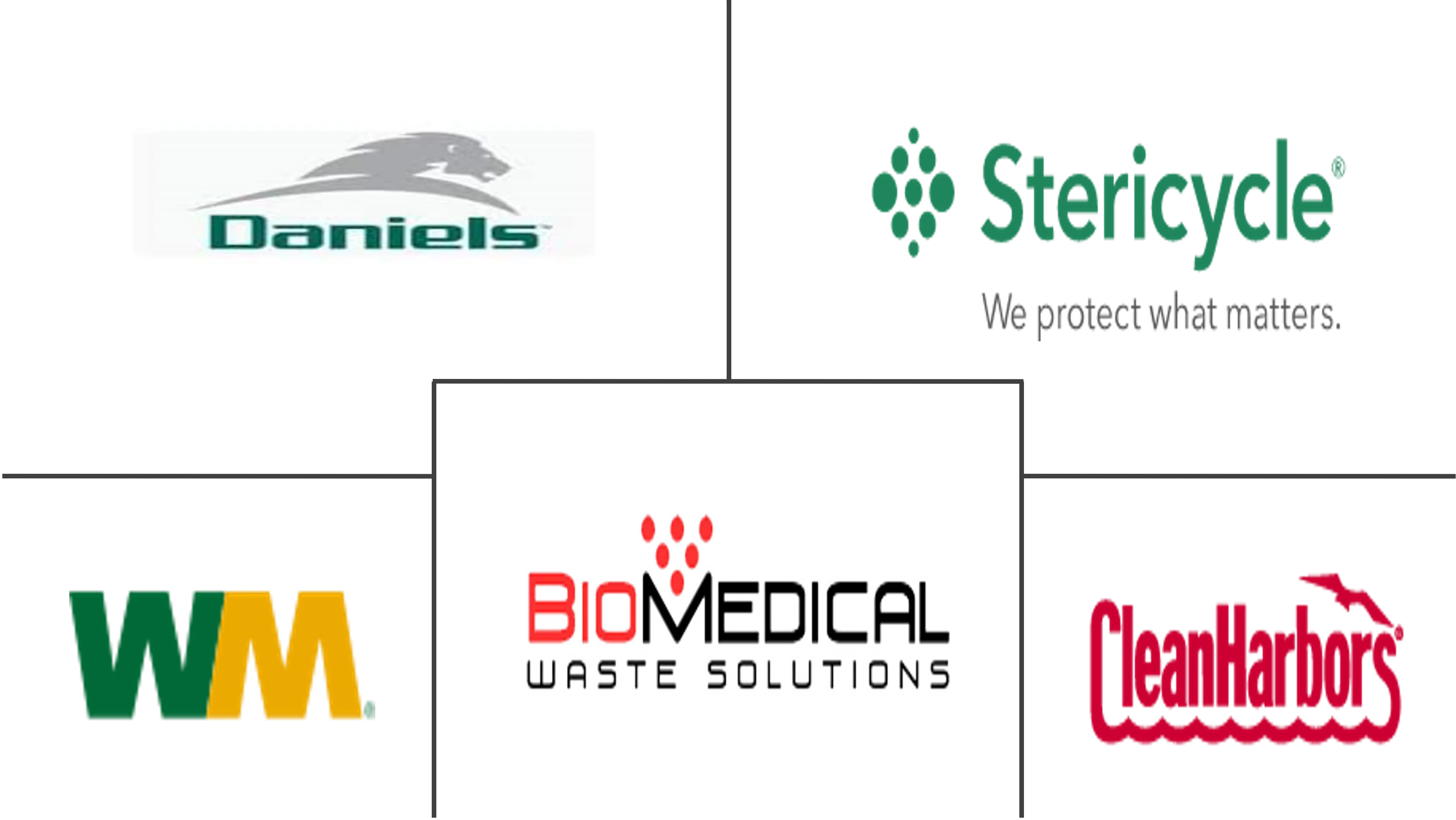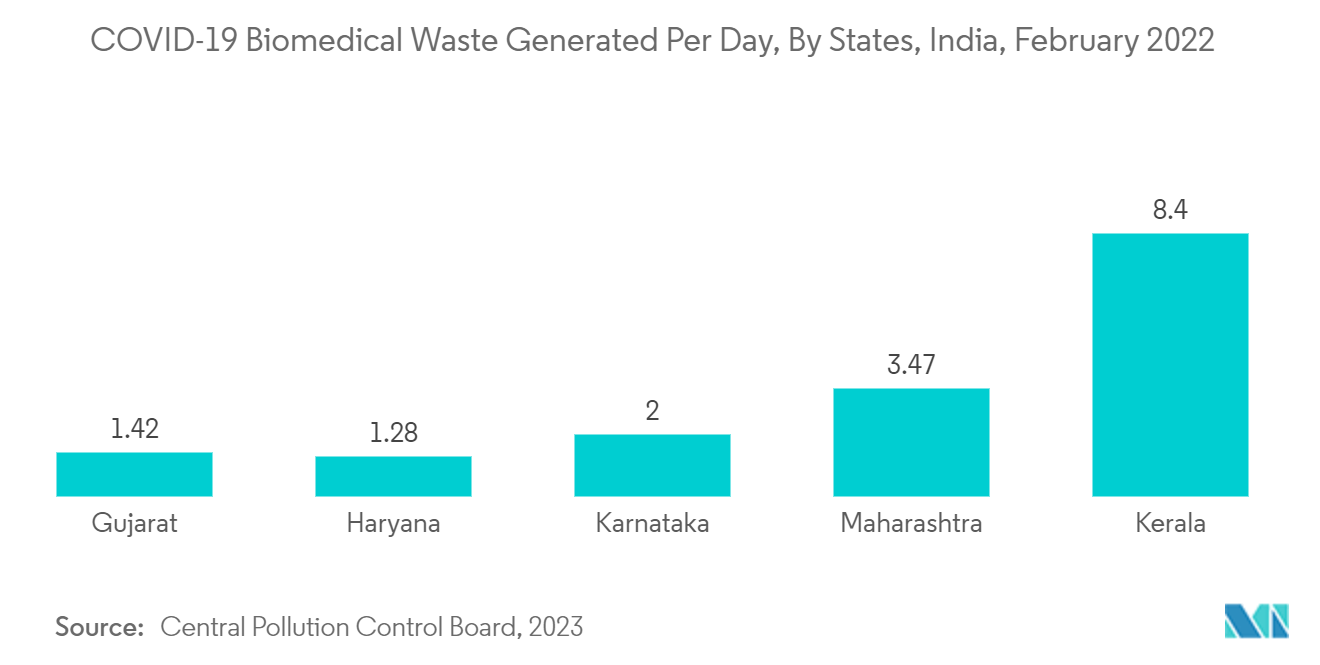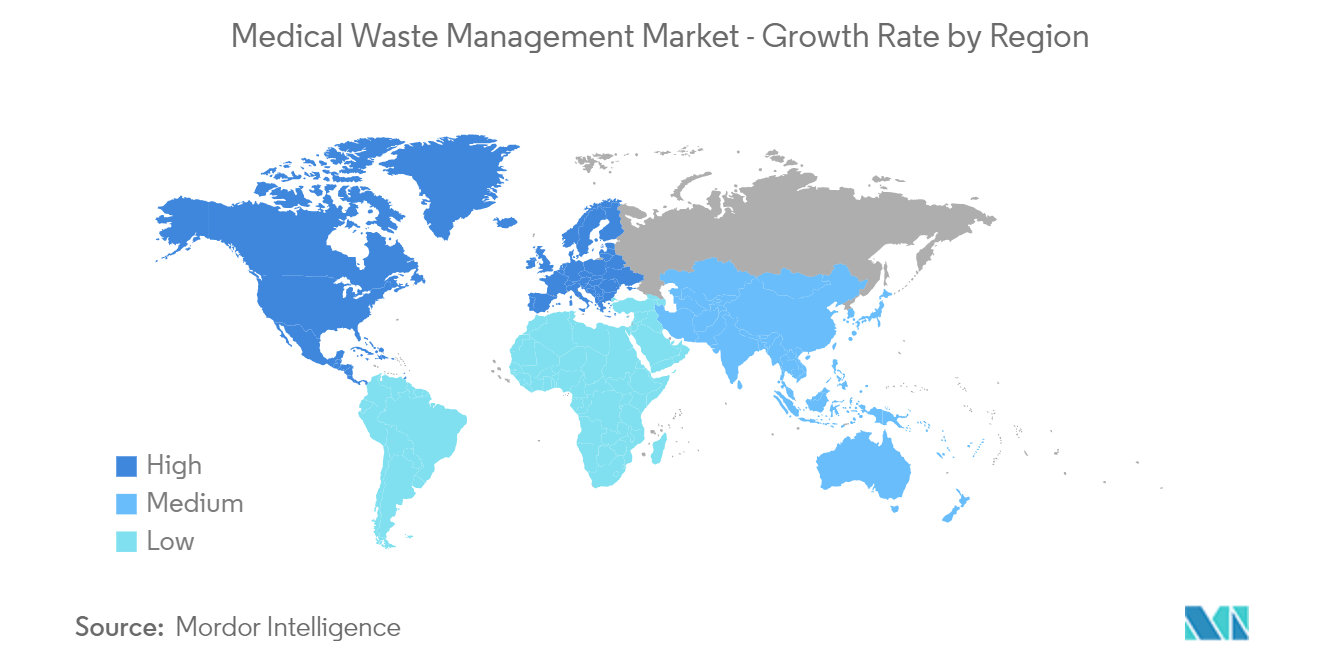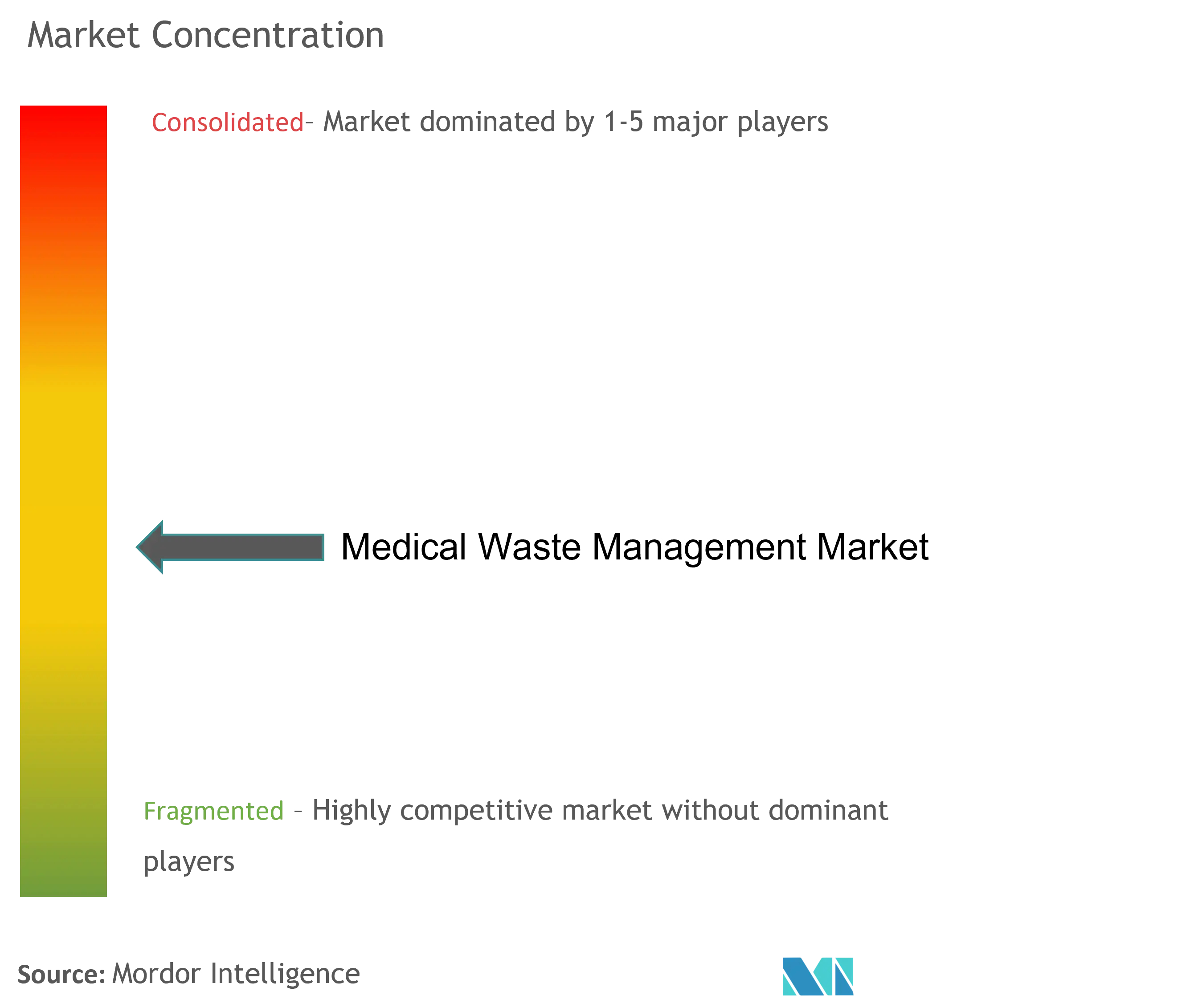Medical Waste Management Market Size

| Study Period | 2019 - 2029 |
| Market Size (2024) | USD 17.40 Billion |
| Market Size (2029) | USD 23.30 Billion |
| CAGR (2024 - 2029) | 6.01 % |
| Fastest Growing Market | Asia Pacific |
| Largest Market | North America |
| Market Concentration | Medium |
Major Players
*Disclaimer: Major Players sorted in no particular order |
Medical Waste Management Market Analysis
The Global Medical Waste Management Market size is estimated at USD 17.40 billion in 2024, and is expected to reach USD 23.30 billion by 2029, growing at a CAGR of 6.01% during the forecast period (2024-2029).
Key drivers fueling the expansion of the medical waste management market encompass heightened initiatives by government entities, a growing awareness surrounding medical waste, and a surge in medical waste generation globally.
The volume of medical waste generated across the world is surging with the increase in the prevalence of chronic diseases and the rise in global population. This trend is set to boost the demand for medical waste management products in the coming years. Governments and private entities worldwide are implementing proactive measures in response to the escalating medical waste challenge. For instance, in August 2022, Brightmark and Jamar Health Products entered a strategic partnership to recycle plastic medical waste from various healthcare settings. Brightmark provides a sustainable and circular solution for recycling, converting Jamar's proprietary PATRAN plastic slides into low-carbon fuels and building blocks for circular plastics. In conclusion, the increasing prevalence of chronic diseases and the growing global population are contributing to a significant portion of medical waste. This surge is expected to necessitate enhanced medical waste management solutions during the forecast period.
In addition, a growing number of government-sponsored programs are also driving the market for medical waste management. Several government agencies adhere to laws relating to medical waste. These include the Occupational Safety and Health Administration (OSHA), the Centers for Disease Control (CDC), the US Food and Drug Administration (FDA), the Department of Transport (DOT), and the Drug Enforcement Administration (DEA). Additionally, the initiatives taken by the governments of different countries are also propelling the market's growth. For instance, in August 2022, in a significant move toward sustainable waste management, the Indian government virtually inaugurated a decentralized biomedical waste incinerator at the Buxar Municipality in Bihar. This innovative technology, crafted by Ganesh Engineering Works, emerged as the frontrunner in the Biomedical Waste Treatment Innovation Challenge. In conclusion, the medical waste management market is significantly driven by government-sponsored programs and adherence to regulatory laws by agencies.
Similarly, in February 2022, Envetec Sustainable Technologies Limited launched its GENERATIONS technology. It is a breakthrough cleantech solution that safely treats biohazardous waste and materials, including plastics, glass, PPE, sharp containers, and other general laboratory consumables, on-site at the source. This innovative cleantech solution enables the safe, on-site treatment of various biohazardous materials, thereby enhancing safety and efficiency in waste management practices and driving the growth of the medical waste management market.
Therefore, factors such as the active participation of government organizations to tackle the high amount of medical waste generated from healthcare settings and the rising number of novel medical waste management product launches are projected to drive market growth during the forecast period. However, the need to invest heavily due to the demand for high-value equipment and new technological equipment may hinder the development of the medical waste management market.
Medical Waste Management Market Trends
The Incineration Segment is Estimated to Witness a Significant Market Share Over the Forecast Period
The incineration segment of the medical waste management market plays a crucial role in ensuring the safe disposal of hazardous medical waste. This method involves burning waste at high temperatures to reduce its volume and eliminate harmful pathogens. For instance, according to the article published by BMC Public Health in October 2023, hospitals are setting up incineration systems based on sophisticated technology for hazardous medical wastes with lower combustion costs globally. The adoption of advanced incineration systems highlights the ongoing efforts to enhance the efficiency and cost-effectiveness of medical waste management, ensuring a safer environment and better public health outcomes. Factors such as convenience and lower capital investments are likely to boost the growth of this segment over the forecast period.
Amid the pandemic, several hospitals and healthcare settings considered incineration one of the best options for medical waste disposal as it restricted the spread of the virus to a greater extent. For instance, according to the World Health Organization published in February 2022, approximately 97.0% of plastic waste from the COVID-19 trial was burned. In addition, government programs and new ventures are projected to boost the segment’s growth over the forecast period.
The incineration segment of the medical waste management market is witnessing significant advancements, driven by the need for safe and efficient disposal methods for hazardous biomedical waste. In June 2023, Kochi began the incineration of its domestic biomedical and sanitary wastes at the twin-chamber high-temperature facility of Kerala Enviro Infrastructure Limited (KEIL) located in Ambalamedu. KEIL's leadership in initiating biomedical waste incineration at Ambalamedu marks a pivotal advancement in the medical waste management market. This facility bolsters the region's ability to safely incinerate biomedical waste at high temperatures, tackling environmental and health issues tied to improper waste management. By designating a specific site for this operation, the project adheres to regulatory standards. Furthermore, it strengthens the waste management infrastructure, a necessity given the rising volumes of medical waste, especially in the wake of the pandemic. The establishment of advanced incineration facilities underscores the ongoing efforts to improve medical waste management infrastructure. These developments are essential for addressing the growing volumes of biomedical waste and ensuring compliance with environmental and health regulations.
Therefore, despite environmental concerns, the high adoption of incineration technology for medical waste management is expected to drive segment growth over the forecast period.

North America is Expected to Hold a Significant Share of the Market Over the Forecast Period
North America is expected to witness considerable growth due to a highly developed health sector, an increase in infectious and chronic diseases requiring advanced medical and surgical resources and treatment, and favorable initiatives related to medical waste management. For instance, in February 2023, Canada's Vitacore Industries launched the country's first complete single-use mask and recycling program. The company collaborated with McMaster University and the University of British Columbia to reduce the environmental impact of PPE waste and disposable masks. Therefore, such initiatives are expected to propel the market growth in the region over the forecast period.
The product launches and favorable initiatives undertaken by the market players are also propelling the market growth in the United States. For instance, in May 2022, Stericycle and UPS Healthcare entered a partnership to manage the reverse logistics of medical waste. According to the agreement, Stericycle is expected to help UPS Healthcare manage the reverse logistics of medical waste, including waste classification and disposal. UPS and Stericycle are projected to provide end-to-end logistical support to the healthcare industry through this partnership.
Similarly, in October 2023, Becton, Dickinson and Company and Casella Waste Systems Inc., a solid waste, recycling, and resource management services company, revealed the results of a recycling pilot to manage discarded syringes and needles that led to 40,000 pounds of medical waste being recycled and diverted from disposal in the United States.
Thus, the active involvement of prominent players in medical waste management in the region through various strategies, such as product launches and partnerships, is projected to drive market growth in the region over the forecast period.

Medical Waste Management Industry Overview
The medical waste management market is moderately consolidated. Companies are also adopting various growth strategies, such as partnerships, agreements, mergers, and acquisitions, to strengthen their presence in the medical waste management market. Some major market players are Biomedical Waste Solutions, Clean Harbors, Daniels, Sharpsart Inc., Stericycle Inc., and WM Intellectual Property Holdings LLC.
Medical Waste Management Market Leaders
-
Biomedical Waste Solutions, LLC
-
Clean Harbors, Inc.
-
Daniels Sharpsmart Inc.
-
Stericycle, Inc.
-
Waste Management, Inc.
*Disclaimer: Major Players sorted in no particular order

Medical Waste Management Market News
- March 2024: Scientists at the CSIR-National Institute for Interdisciplinary Science and Technology (CSIR-NIIST) developed an innovative technology for the safe, sustainable, and cost-effective management of biomedical waste in India. They developed a dual disinfection-solidification system to disinfect and immobilize pathogenic biomedical wastes from laboratories and operation theatres and convert them into value-added soil additives.
- August 2023: Stericycle Inc. launched its re-engineered one-gallon SafeDrop Sharps Mail Back and one-gallon CsRx Controlled Substance Wastage containers, which provide customers with a contemporary design, improved ease of use, and a more sustainable product.
Global Medical Waste Management Market Report - Table of Contents
1. INTRODUCTION
1.1 Study Assumptions and Market Definition
1.2 Scope of the Study
2. RESEARCH METHODOLOGY
3. EXECUTIVE SUMMARY
4. MARKET DYNAMICS
4.1 Market Overview
4.2 Market Drivers
4.2.1 Rising Government Support and Awareness Initiatives
4.2.2 Increasing Volume of Healthcare Waste
4.3 Market Restraints
4.3.1 High Capital Investment and Increasing Costs
4.3.2 Lack of Training and Awareness
4.4 Porter's Five Forces Analysis
4.4.1 Bargaining Power of Buyers/Consumers
4.4.2 Bargaining Power of Suppliers
4.4.3 Threat of New Entrants
4.4.4 Threat of Substitute Products
4.4.5 Intensity of Competitive Rivalry
5. MARKET SEGMENTATION (Market Size by Value - USD)
5.1 By Type of Waste
5.1.1 Non-hazardous Waste
5.1.2 Hazardous Waste
5.2 By Treatment
5.2.1 Incineration
5.2.2 Autoclaving
5.2.3 Chemical Treatment
5.2.4 Other Treatments
5.3 By Service
5.3.1 Collection, Transportation, and Storage
5.3.2 Treatment and Disposal
5.3.3 Recycling
5.3.4 Other Services
5.4 By Treatment Site
5.4.1 Offsite Treatment
5.4.2 Onsite Treatment
5.5 Geography
5.5.1 North America
5.5.1.1 United States
5.5.1.2 Canada
5.5.1.3 Mexico
5.5.2 Europe
5.5.2.1 Germany
5.5.2.2 United Kingdom
5.5.2.3 France
5.5.2.4 Italy
5.5.2.5 Spain
5.5.2.6 Rest of Europe
5.5.3 Asia-Pacific
5.5.3.1 China
5.5.3.2 Japan
5.5.3.3 India
5.5.3.4 Australia
5.5.3.5 South Korea
5.5.3.6 Rest of Asia-Pacific
5.5.4 Middle East and Africa
5.5.4.1 GCC
5.5.4.2 South Africa
5.5.4.3 Rest of Middle East and Africa
5.5.5 South America
5.5.5.1 Brazil
5.5.5.2 Argentina
5.5.5.3 Rest of South America
6. COMPETITIVE LANDSCAPE
6.1 Company Profiles
6.1.1 Biomedical Waste Solutions LLC
6.1.2 Clean Harbors Inc.
6.1.3 Daniels Sharpsmart Inc.
6.1.4 Republic Services Inc.
6.1.5 Stericycle Inc.
6.1.6 Suez Environmental Services
6.1.7 Veolia Environnmental Services
6.1.8 Waste Management Inc.
6.1.9 Gamma Waste Systems
6.1.10 Triumvirate Environmental
- *List Not Exhaustive
7. MARKET OPPORTUNITIES AND FUTURE TRENDS
Medical Waste Management Industry Segmentation
As per the scope of the report, medical waste contains infectious materials, and it is the waste generated by healthcare facilities like physician’s offices, hospitals, dental practices, laboratories, medical research facilities, and veterinary clinics. Medical waste can contain bodily fluids like blood or other contaminants. Some examples are culture dishes, glassware, bandages, gloves, discarded sharps like needles or scalpels, swabs, and tissue. The medical waste management market involves the handling, treatment, and disposal of wastes generated by healthcare facilities such as hospitals, clinics, laboratories, and research centers.
The medical waste management market is segmented by type of waste, treatment, service, treatment site, and geography. By type of waste, the market is segmented into non-hazardous waste and hazardous waste. By treatment, the market is segmented into incineration, autoclaving, chemical treatment, and other treatments. By service, the market is segmented into collection, transportation, and storage, treatment and disposal, recycling, and other services. By treatment site, the market is segmented into offsite and onsite treatment. By geography, the market is segmented into North America, Europe, Asia-Pacific, the Middle East and Africa, and South America. The report also offers the market size and forecasts for 17 regional countries globally. For each segment, the market size and forecast are provided in terms of value (USD).
| By Type of Waste | |
| Non-hazardous Waste | |
| Hazardous Waste |
| By Treatment | |
| Incineration | |
| Autoclaving | |
| Chemical Treatment | |
| Other Treatments |
| By Service | |
| Collection, Transportation, and Storage | |
| Treatment and Disposal | |
| Recycling | |
| Other Services |
| By Treatment Site | |
| Offsite Treatment | |
| Onsite Treatment |
| Geography | ||||||||
| ||||||||
| ||||||||
| ||||||||
| ||||||||
|
Global Medical Waste Management Market Research Faqs
How big is the Global Medical Waste Management Market?
The Global Medical Waste Management Market size is expected to reach USD 17.40 billion in 2024 and grow at a CAGR of 6.01% to reach USD 23.30 billion by 2029.
What is the current Global Medical Waste Management Market size?
In 2024, the Global Medical Waste Management Market size is expected to reach USD 17.40 billion.
Who are the key players in Global Medical Waste Management Market?
Biomedical Waste Solutions, LLC, Clean Harbors, Inc., Daniels Sharpsmart Inc., Stericycle, Inc. and Waste Management, Inc. are the major companies operating in the Global Medical Waste Management Market.
Which is the fastest growing region in Global Medical Waste Management Market?
Asia Pacific is estimated to grow at the highest CAGR over the forecast period (2024-2029).
Which region has the biggest share in Global Medical Waste Management Market?
In 2024, the North America accounts for the largest market share in Global Medical Waste Management Market.
What years does this Global Medical Waste Management Market cover, and what was the market size in 2023?
In 2023, the Global Medical Waste Management Market size was estimated at USD 16.35 billion. The report covers the Global Medical Waste Management Market historical market size for years: 2019, 2020, 2021, 2022 and 2023. The report also forecasts the Global Medical Waste Management Market size for years: 2024, 2025, 2026, 2027, 2028 and 2029.
What are the key trends in the Medical Waste Management Market?
The key trends in the Medical Waste Management Market are a) Incineration segment is expected to garner the largest share in the market b) North America is expected to hold a significant share in the market c) Increasing amount of medical waste produced will increase the need for a variety of medical waste management treatments.
Global Medical Waste Management Industry Report
This comprehensive report offers a deep dive into the medical waste management industry, providing a detailed analysis of key market drivers and market segments. Mordor Intelligence offers customization based on your specific interests, including: 1. Treatment Type: Irradiative, Biological, Microwaving 2. Category: Controlled, Uncontrolled 3. Waste Generators: Nursing Homes, Research Centers 4. Type of Waste: Pathological Waste



